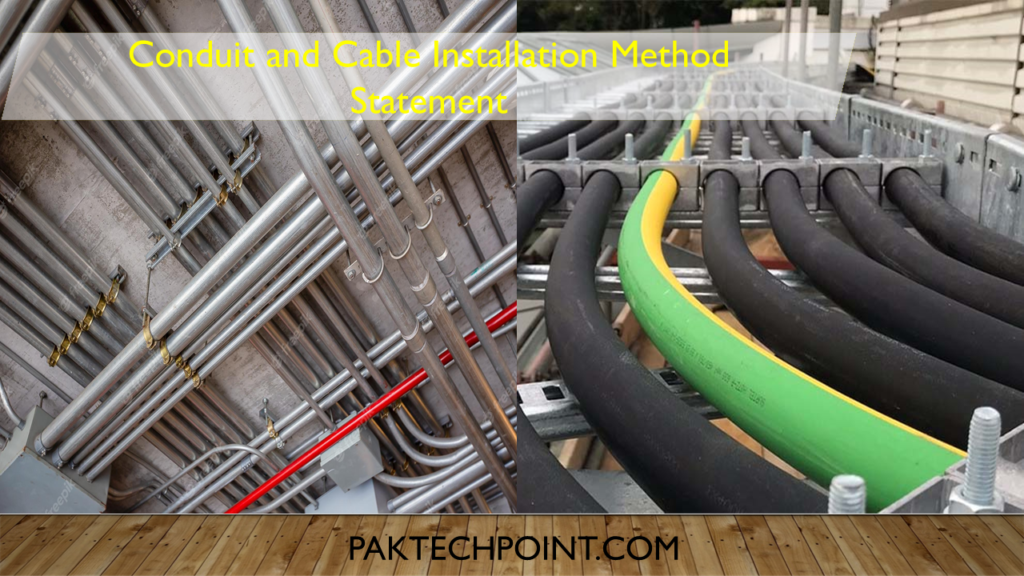This article is about Best Practices as per international codes and standards for Efficient Conduit and Cable Installation.
In electrical engineering, the proper installation of conduit and cable is paramount to ensure safe and reliable electrical systems. This article delves into the essential guidelines and practices for conduit and cable installation, emphasizing compliance with codes and specifications.

What is Conduit and Cable?
Conduit, in the context of electrical engineering and construction, refers to a system of pipes or tubing used to protect and route electrical wires and cables. It provides a protective enclosure for electrical conductors, shielding them from physical damage, moisture, chemicals, and other environmental factors. Conduit systems are essential for both safety and organization in electrical installations.
In the context of electrical engineering and construction, a cable is a combination of two or more insulated wires or conductors bundled together within a protective sheath. Cables are used to transmit electrical power or signals from one point to another. They come in various types and configurations, each designed for specific purposes. Here are some common types of cables:
Conduit and Cable Installation Method Statement
1. Conduit Installation
1.1. Compliance with Codes: Conduit installation should adhere to contract drawings, the National Electrical Code (NEC), local codes, and specific project specifications. When discrepancies arise, the strictest requirements should prevail.
1.2. Conduit Routing: The routing of conduit should be meticulously planned to prevent tripping hazards, obstruction of walkways, and interference with equipment and valves. Coordination with other trades is crucial to avoid conflicts.
1.3. Avoiding Weight on Equipment: Rigid or flexible conduit should not be used as a means of supporting instrumentation or valves, especially solenoid valves, as the weight of the conduit can damage casings and lead to valve failure.
1.4. Conduit Cutting: Metal conduit should be cut using appropriate tools such as a power hacksaw, band saw, or rotary pipe cutter. Additionally, interior reaming should be performed to eliminate any burrs.
1.5. Joint Protection: Galvanized steel and aluminum conduit joints must be coated with a metallic lubricant sealant to enhance protection against corrosion.
1.6. Span Limitations: Conduit runs on pipe bridges or dedicated structures should adhere to NEC requirements regarding span limitations.
1.7. Bushings: Metal conduit terminations require nylon-insulating throat bushings to prevent wire damage. Conduit terminating in nonmetallic enclosures should have nylon-insulating grounding bushings, all of which should be interconnected with a copper wire equivalent to the largest grounding conductor within the enclosure.
1.8. Flexible Conduit: Low-voltage motors in non-hazardous and Class 1, Division 2 hazardous areas should incorporate liquid-tight flexible conduit (LFMC) sections at motor terminal boxes to accommodate belt take-up and isolate vibration.
1.9. Sealing Compound: After cable installation, conduit runs terminating at cable trays must be adequately sealed with an approved compound to maintain environmental integrity.
1.10. Cable Entry: Conduit and cable should enter field instruments, cabinets, terminal boxes, and switches at bottom or side connections only to prevent water drainage into these components.
1.11. Spare Conduits: Installation should include spare conduits as indicated in drawings, with proper cleaning and end caps installation.
1.12. Above-Ground RNC: Rigid Nonmetallic Conduit (RNC) installation should follow specific guidelines, including the use of proper bending equipment, solvent cement for joints, expansion couplings for long runs, and adequate support.
2. Cable Installation
2.1. Cable-Pulling Compound: Cable pulls in conduit should utilize cable-pulling compound, such as Polywater “J,” to reduce friction and facilitate smoother installations. The chosen compound must be certified as harmless to the cable type used.
2.2. Medium Voltage Cable: When pulling medium voltage cable in conduit, conductors should be used for pulling, not just the insulation or cable jacket.
2.3. Low Voltage Cable: Industry-accepted methods and tools designed for wire and cable pulling should be employed for low voltage cable installations.
2.4. Tension Meter/Recording: A tension meter/recording device should be employed for all cable and wire pulls, with recorded data available for review.
By adhering to these guidelines and best practices, electrical engineers and contractors can ensure the proper installation of conduit and cable, promoting safety, reliability, and compliance with codes and specifications.